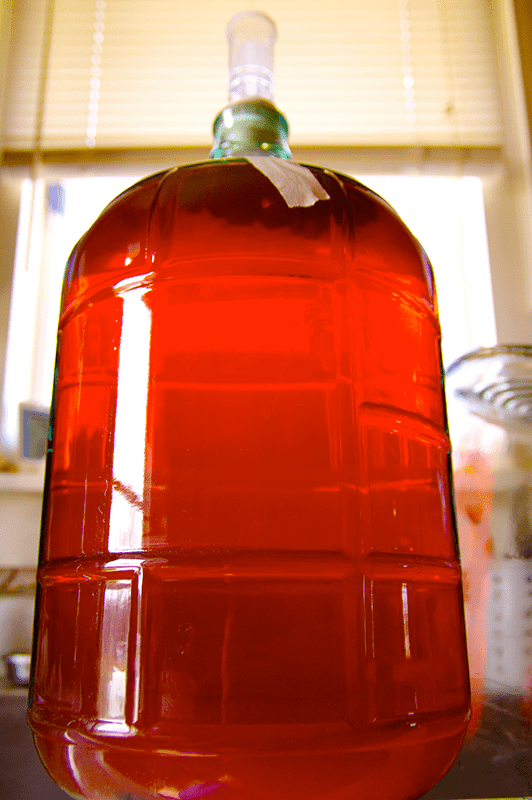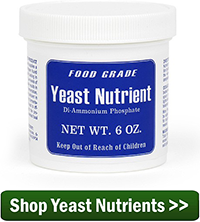 I just started my first batch of Mead. I followed your recipe to the tee. Now after 4 days my SG is 1.062. The Mead is fermenting slow or may have stopped fermenting completely. When will it drop to 1.030-1.040.?
I just started my first batch of Mead. I followed your recipe to the tee. Now after 4 days my SG is 1.062. The Mead is fermenting slow or may have stopped fermenting completely. When will it drop to 1.030-1.040.?
Name: Tony A.
State: SD
—–
Hello Tony,
What you may be experiencing is a stuck mead fermentation. This is something that is not all uncommon when fermenting honey, so don’t feel like you’ve done anything wrong or that the mead is doomed to failure. A slow or stuck mead fermentation is a simple issue with a simple fix. I’m confident you will be successful in restarting the fermentation.
The reason this is happening is because there is an array of varying sugars in honey, each with its own molecular makeup. Some of the sugars have a very complex cell structures. Others are not so complex. These are called complex sugars and simple sugars.
When a mead fermentation starts off, the simplest of the sugars are consumed first. This is because these are the sugars that are easiest for the wine yeast to consume. The yeast grab on to the lowest hanging fruit, first, so to speak. But as the fermentation continues there slowly becomes a point when all that’s left are the more complex sugars.
These sugars have large cell structures that can not be readily consumed by the wine yeast in their current state. The wine yeast must first break down the complex sugars into a simpler form. This is done with enzymes. The wine yeast will naturally excrete enzymes through out the fermentation and even more so when simple sugars are less available. The enzymes break down the complex chains of molecules into something smaller, simpler and easier for the yeast to digest.
Tony, this is where your mead fermentation stands, currently. This is why you have a stuck mead fermentation. It has seemingly hit a brick wall because the wine yeast have ran out of simple sugars to consume. What’s happening now is that they are nibbling away the best they can at the more complex sugars as the yeasts’ enzymes slowly break them down. This equates to a slow fermentation or on that stops, too early.
If you do nothing, the mead fermentation will more than likely finish on its own… eventually. But this is something that could take months to run its course. Fortunately, there are some things you can do to help restart the stuck mead fermentation:
- Review the Top 10 Reasons For Fermentation Failure. See if any of these reasons are contributing to your mead’s stuck fermentation. If they are, see what you can do to resolve it.
- Add magnesium sulfate to the mead. Another struggle for the wine yeast is that a honey fermentation is low in pH. By adding a small amount of magnesium sulfate to the must (1/2 teaspoon to 5 gallons) you can put the wine yeast in the proper playing field for a healthier fermentation.
- Add a 1/2 dose of yeast nutrient to the mead. This would be 3/4 tablespoon to 5 gallons.
By doing the above three procedures, restarting a slow or stuck mead fermentation should come about very easily.
Happy Winemaking,
Ed Kraus
—–
Ed Kraus is a 3rd generation home brewer/winemaker and has been an owner of E. C. Kraus since 1999. He has been helping individuals make better wine and beer for over 25 years.

Wondering if for the same reasons one gets a stuck fermentaion on grape wine.
Thanks,
AT
Tony, unless you used honey to ferment in place of sugar, complex sugars is probably not the issue. There are a number of reasons that can cause a stuck fermentation in any type of wine that you make. Below is the link to an article that discusses the most common causes of fermentation failure.
Fermentation Failure
http://www.eckraus.com/wine-making-failure
Your article States three proceedures to be followed for addressing stuck fermentations. I only see two. Did I miss something?
Gordon, sorry for the confusion. The three steps or procedures mentioned are to check the article on the most common reasons for fermentation failure to see if any other reason may apply, add magnesium sulfate and add yeast nutrient.
If temperature is suspected for a stuck fermentation I will place my heating pad that I use for my back on the side of the carboy and then wrap the carboy with a towel. this will usually free up a stuck fermentation.
I have 2 batches of plum stuck, both was set at 16% one is at 9% the other at 11%. Both are setting in a room that is always 72 degrees, they work a little every 6 months or so. I added more yeast, later yeast nutrient, and still later some melted sugar. Nothing seem to help. At least both has aged, one was set in 2016 the other in 2017.
I was using a heating pad for a batch of mead but not watching the temp, it seems slow compared to a batch I made years ago I just found the temp was 90 Fahrenheit, it is bubbling a bit but not much so my questions are if I cool it to 70 degrees or so will that help the ferment? Also is there anything I could add like yeast nutrient and mag sulfate to help it along after being too hot? The yeast is saccharomyces cerevisiae, (lavin EC 1118).
Bill, once you start getting over 80°F. you run the risk of off-flavors and possible spoilage. In addition, 85 degrees and above–the wine yeast cells may become damaged inhibiting their ability to ferment. I would get the temperature cooled down to 70-75 degrees and add new yeast.
If my starting SG was 1.106, and after one month is 1.063, but still bubbling through the air lock about once every 20 seconds, would this be considered stuck?
Steven, I would consider this a slow fermentation. It is still fermenting but very slowly. I would take a look at our articles on the top reasons for having a stuck or sluggish fermentation to see if any apply to your situation.
Top Reasons For Fermentation Failure
https://eckraus.com/wine-making-failure/
Would Malic acid aid in adjusting the Ph?
Matt, while acid blend is the most commonly used, you can use malic acid to adjust the pH. For more information on acid adjustment, please see the article link below.
Wine Making Acidity
https://eckraus.com/wine-making-acidity/
When I make Meade I usually use local honey. This time I use some honey from Argentina. I have put in yeast nutrient and energizer as well and I cannot get it to ferment I’ve tried to three packets of yeast still nothing I’ve tried sodium sulfate, nothing what else can I use. It’s been over a week now is my batch completely ruined? Would it be worth taking it out and boiling the honey down first
So I started a batch of traditional mead, but I wanted it to be a sweeter version with about 16%. My starting SG was roughly 1.160, and right now reads about 1.122 after a couple weeks. I had the same kind of setup with a melomel (making blood mead lol), however with it being on fruit I wound up splitting it in half and topping it off to bring it down to 1.130. My question is this: I had split the melomel and repitched the yeast (in fear of the fruit spoiling after a few days of delayed activity), and in the same amount of time the melomel has chewed away to bring it down to a SG of 1.022. Since the traditional is still going, but is slow even with a full dose of nutrients, would treating the traditional the same way I treated the melomel kick it up to a faster rate? I plan on clearing and bulk-aging these for a few months before bottling, so could my theory work? Both are kept at a consistent 66-68 degrees in my home.
My husband’s Meade has been fermenting FOREVER, several months, maybe a year? Would it be ok to drink? Or should we throw it out and try again?
Hi,
What about the risk of your “wine, mead or whatever you are doing” turning into acetic acid during the period of those 4-6 days without airlock?
Is there any way you can prevent this?
I had this happened to me in within 6 days.
No added yeast, only sugar and fruit. Had done it a few times but for some reason, this time got messed up 🥴…
Thanks!
Johnny